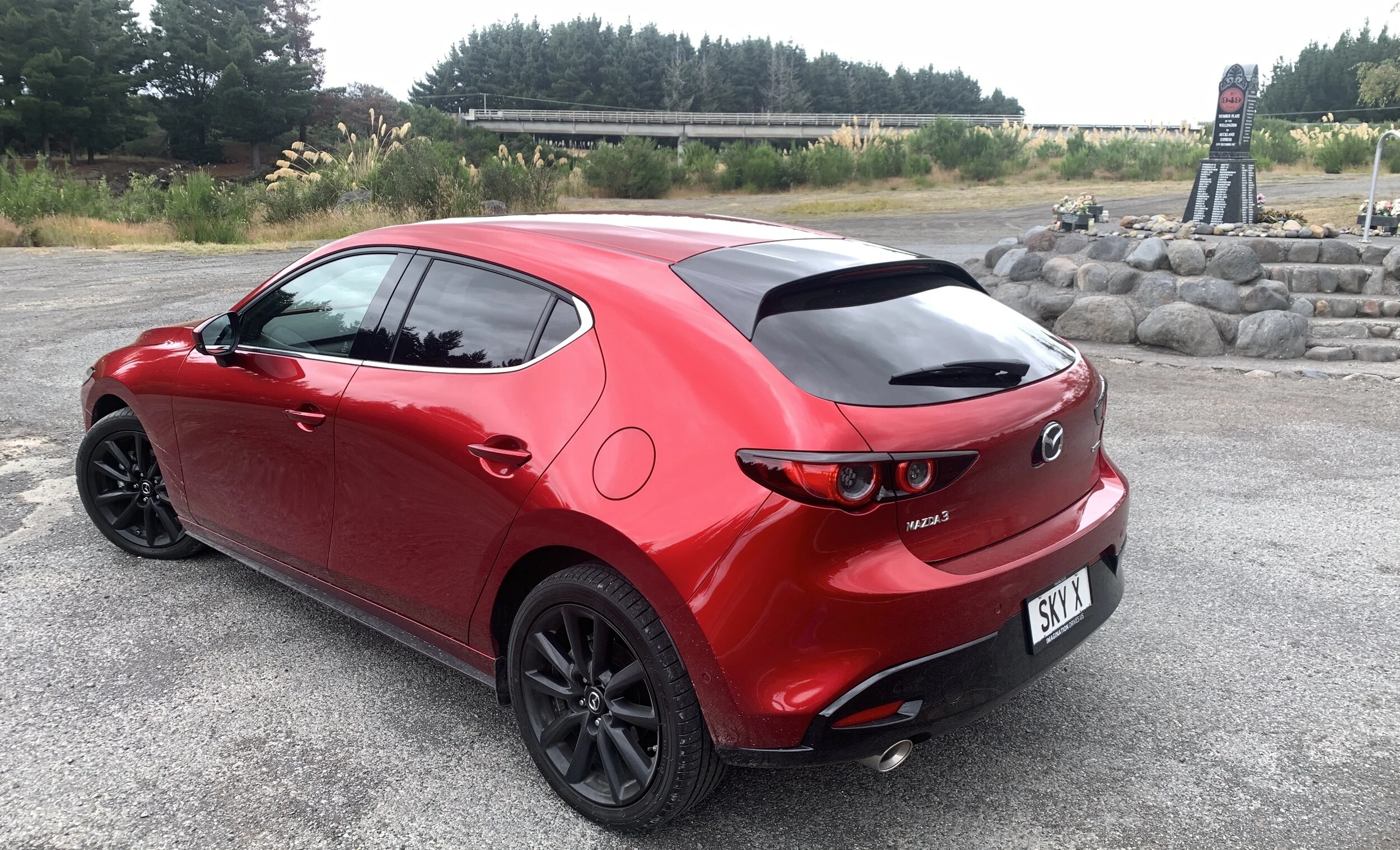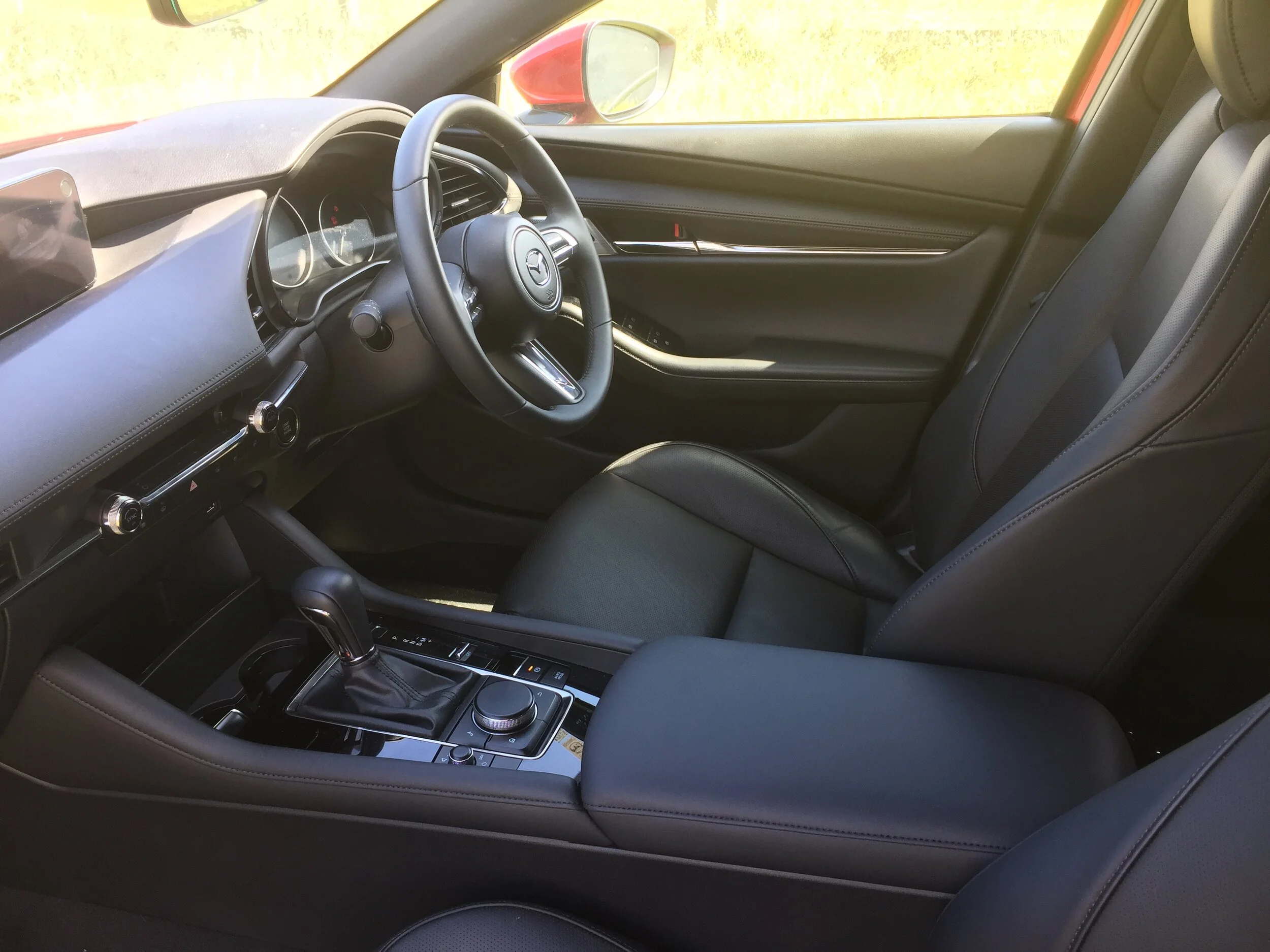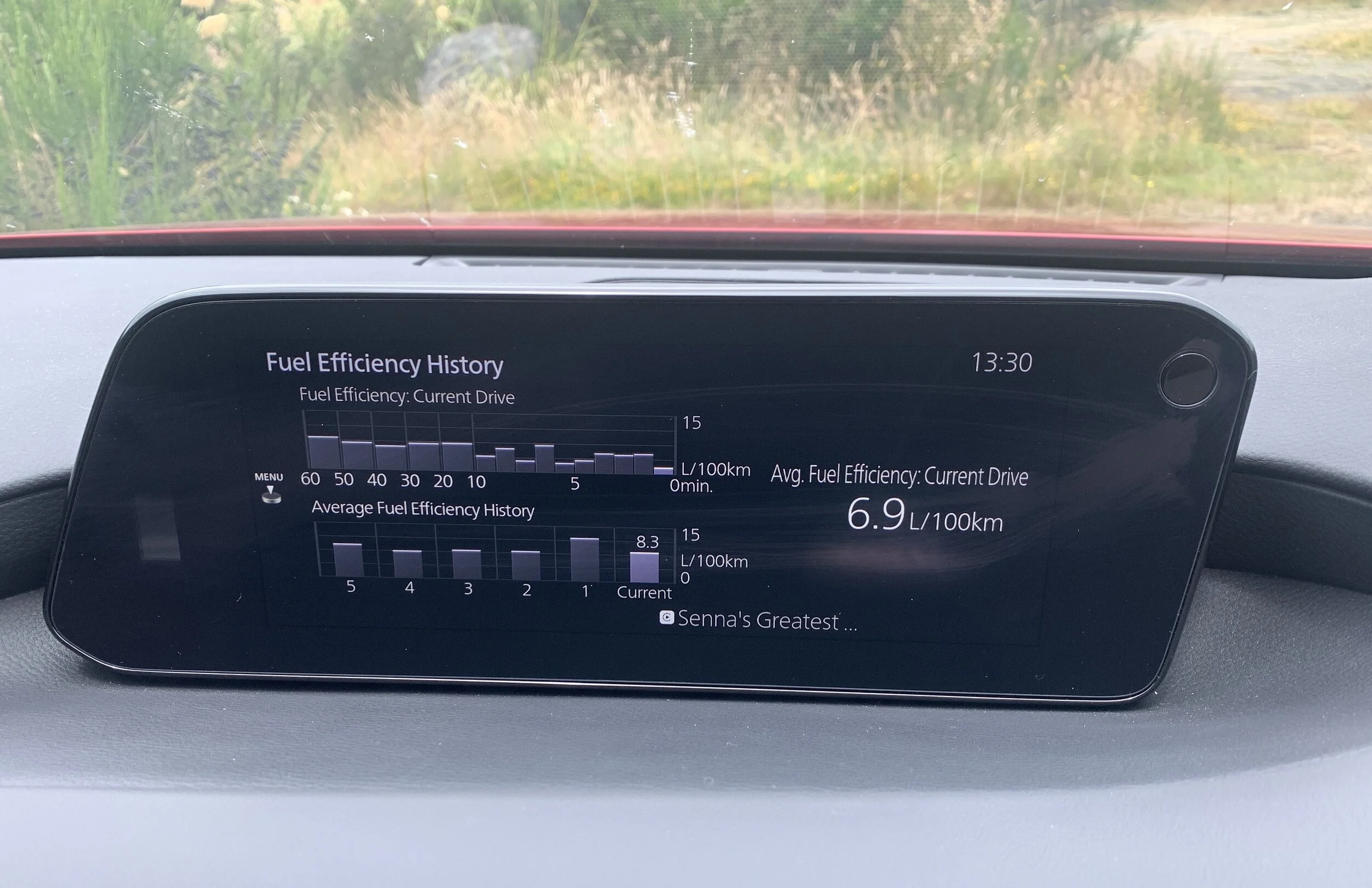Mazda3 SkyActiv-X: So petrol’s dead? Hold that thought …
/Combining an innovative engine into a styling package.
Price: $51,995
Powertrain and economy: 2.0-litre four cylinder SkyActiv-X mild-hybrid petrol engine, 132kW/224Nm. Six-speed automatic transmission with Sport mode. Front-wheel drive. Combined fuel consumption 5.5 L/100km.
Vital statistics: Length 4460mm, height 1435mm, width 1795mm, wheelbase 2725mm. Luggage space 295 litres. Wheels 18-inch alloys, 215/45 R18 tyres.
We like: Revolutionary tech; build quality; nimble handling.
We don’t like: Hatch configuration; some road noise; priced on wrong side of $50k.
PUSHING boundaries is a Mazda thing – going rotary, dabbling with hydrogen, re-inventing the sports car. So much beyond-the-box thinking.
At a time, then, when so many other brands are announcing intent to either freeze ongoing internal combustion engines or even drop them altogether, it probably shouldn’t come as a surprise that the Hiroshima concern is putting a dollar each way.
Soon, we’ll have its first electric, a small crossover, the MX-30. The first of many and an obvious step into the future. It’s set to reside alongside cars with a petrol engine that, by dint of being the world’s first with compression-ignition, is also something of a breakthrough.
But also a step into the future? I can understand some being confused by that proposition. After all, as clever as the SkyActiv-X is, it’s still an internal combustion engine requiring a hydrocarbon fuel. Judging by some of the headlines we've seen recently, you could be forgiven for thinking that’s just the wrong thing.
Hiroshima doesn’t believe so. Every signal suggests that it continue with this innovative powertrain for as long as there’s fuel to feed it, and not through indifference to motoring heading to an electric future.
There’s no alternate thinking from Mazda about the final outcome. Yet it is among legacy carmakers with belief that global transition away from fossil fuels is going to take a lot longer than those early adopters of Nissan Leafs and Teslas would have us believe and that, accordingly, there will be a coexistence between internal combustion engines and electric drive systems for a certain period, perhaps until 2050, for all sorts of reasons, including acceptance that electric also means ‘electrified’. It’s important what the latter actually means.
It can, of course, refer to fully electric battery powered vehicles. But it can also be used to describe hybrids - and hybrids come in many forms.
Plug-in hybrids of the moment tend to have a large battery capacity and are often capable of running entirely on electric power at least part of the time, though they will have a petrol engine as well. The most efficient type is essentially an electric car with an engine acting as an on-board generator. Even in instances where countries outlaw purely conventional wholly fossil-fuelled vehicles, the latter will remain accepted. Potentially, that subservient role is one SkyActiv-X (or, for that matter, a rotary) might ultimately fall into.
However it plays out, Mazda reckons that we should at least be favouring internal combustion approaches that make better possible use of every drop of fuel.
That’s what SkyActiv-X is all about. The outcome of massive investment is, in most basic terms, a powerplant that ups the ante for petrol performance – more in regard to emissions and economy than urge, though there is more of that – by effectively involving the compression ignition principles that have historically associated with diesel.
The complexities have been explained before, so need no review now, yet what you need to know is that a week spent with a Mazda3 Takami with the SkyActiv-X 2.0-litre was an eye-opener. When it goes lean, it can get very lean indeed.
At same token, my own experience suggests there’s a degree of a ‘right place, right time’ theme to it and that the longer you spend with it, the more you learn and appreciate when it might provision the 20 percent better fuel economy than a comparable ‘orthodox’ Mazda engine might deliver.
The main test during this evaluation was a 300km continuous drive. During this, there were times when it seemed on the verge of out-thrifting something like a Toyota Prius. And times when it seemed no more parsimonious than a ‘regular’ four-cylinder Mazda3.
Quite why these outcomes unfolded when they did and why, and how knife-edge the circumstances, likely requires more scientific analysis than my brain is capable of.
Obviously, yes, it is lean at low speed. Yet, at open road pace, it will also eke remarkably. That long-distance run ended on a 6.4 litres per 100km average, but at the halfway point it was down to 5.4.
That latter figure came after a prolonged stint on reasonably easy-going, yet occasionally ascent-involving, highway. The last sector involved more seriously winding hill country road; with deeper throttle engagements required. Obviously, there was a price to pay for that. Even so, a trump card. At journey’s end, with half a tank of fuel consumed and 366kms clocked, the car’s trip computer was showing that range expectation had cumulatively improved by around 60km.
Huh? Another quirk. I’d swear that, when driven on light throttle at that pace, it was more economical in the sport mode than the economy setting.
This experience alone leaves me imagining ownership will be an ongoing learning experience. It seems to be that way for Mazda, too. The engine as it represented during test seems now to have since further overseas’ evolution to further refine performance, yield a bit more oomph and also enhance CO2 saving, though overall emissions still stand above the 105 grams per kilometre average the Government is toying with as an ambition for 2025.
As I drove it, the engine impresses for its refinement, particularly at low-load cruising, and its driveability; while it doesn’t have the zest for running to the redline, there is definitely superior low-down response. Though it remains at its core a nat-asp petrol engine, there’s nonetheless a crispness to it that you might imagine is above-average for a unit that lacks a turbocharger.
For sure, in the main it functions, feels and drives like a regular petrol-powered car, all the same, so to get a handle on what makes it different you need pay heed to dedicated displays that reveal what is going on and when during a drive. It’s fascinating to see how often it is switching between Spark Controlled Compression Ignition (SPCCI) – mostly under acceleration - and the regular form of spark ignition (which it tends to revert to when coasting). It also has hybrid assistance and, though the electric assist is modest in size and capacity, this also enacts enthusiastically.
In respect to that side, best avoid calling it a mild hybrid. I know saying this will set me up for an argument; for a start, it’s a view at odds with that put by Rob Maetzig in his own assessment of this very same car, published in this site on February 15. https://www.motoringnz.com/tested/2021/2/15/mazda3-skyactiv-x-lighter-shade-of-hybrid?rq=skyactiv-x
Why don’t I agree? Because I feel that term simply opens it up to comparison with something like a Prius. There’s no commonality. Mazda’s system doesn’t operate in the same way, nor does it offer all the same benefits. Where the electric part of Toyota hybrid can function in place of the petrol engine, Mazda's implementation can only assist; the petrol engine is always running in tandem.
The bigger question with the SkyActiv-X is whether or not it is worth the premium over the orthodox 2.5-litre engine that Mazda also offers. That unit spans more models, makes similar power and torque and feels awfully similar in terms of general performance.
The SPCCI is straight away the ‘greener’ car in respect to its emissions, but I’ll say it’s going to take time to patently prove itself in respect to absolute through fuel savings. Those who haven’t the patience or aren’t running it in a way that’ll deliver short-term dividends might question the need.
Settling the new engine into the Mazda3 five-door is a good start; this is definitely Japan’s most appealing compact hatchback in terms of driving feel; it is an engaging car with a chirpy personality. And the look? It’s far from aesthetically controversial, but the scarab beetle silhouette is something I struggle with.
The hybrid side introduces a battery but the cargo capacity remains the same as the regular version. The 295 litres’ space is not huge, overshadowed by the Mazda3 sedan and, of course, the car that is effectively a Mazda3 hatch on stilts, the CX-30 crossover, but it’s usefully shaped.
The bespoke displays aside, the interior design is just as you’ll find in any other Mazda3, though with high grade materials as the SkyActiv-X comes Takami trim.
The classy cabin is a major plus point. The design is simple and sporty but ambience is emphatically upmarket. Mazda’s intent is to basically emulate like-sized European prestige models and they’ve done a great job. A dashboard and door toppings clad in soft, pretend leather that looks and feels as good as the real deal, brushed-aluminium-finish speaker grilles for the 12-speaker Bose premium audio system; these alone are elements that leave this car sitting above anything else of its type from Japan, if not everything from Europe. That new VW Golf 8 is even smarter.
The 8.8-inch screen on top of the dash is, unusually, not a touch-screen but is instead linked to rotary controller behind the gear lever, yet it’s intuitive and easy to use. Likewise the pared-back air-conditioning controls.
Cabin space is fine up front, with plenty of legroom and headroom. Impression from the styling suggests they’ve lifted the rear part of the roofline, but that;s actually a visual subterfuge. It’s quite cramped and the small rear windows can make it feel a bit claustrophobic.
Takami ensures every item of advanced safety tech known to Mazda presents. On top of the usual airbags, one for the driver’s knees, and electronic driver aids, there’s automatic emergency braking system, a blind-spot monitoring function and rear cross-traffic alert. There’s also traffic sign recognition, a radar-based cruise control system and a driver alertness function that warns when sensing you’re getting sleepy at the wheel. On top of all that, there’s no argument buyers are attracted by Mazda’s very comprehensive warranty.
All in all, the SkyActiv-X technology remains a fascination; in all probability, what we are experiencing now is just the chapter of a decent book. Quite logically, a future candidate would have to be the new in-line six cylinder engine destined for the next-generation Mazda6 (yes, again, another example of this brand seemingly swimming against the tide; a bigger cylinder count when the whole car world is down-sizing). Obviously it has no diesel application because, well, it’s really doing what diesel does already. And it’s challenging to understand it being attuned into a high-performance aspect, though I guess we should not be surprised if that occurs.
Would I buy into it? Not in this setting, but that’s personal preference; our lifestyle tastes are better met by a compact crossover, and I’m hardly alone. Hence why Mazda also provisions this powerplant into the CX-30. I drove that model at launch and was surprised how different it felt in driving spirit, including sound, to the Mazda3. Will that also evidence in a longer-term association? I’m keen to know.
Meantime, this engine stands to remind that this period of change is hardly quite as clearcut as it seems. Yes, electric is the new big thing and there’s no avoiding that. Yet, if you thought the petrol engine was heading to the scrap heap ….





















